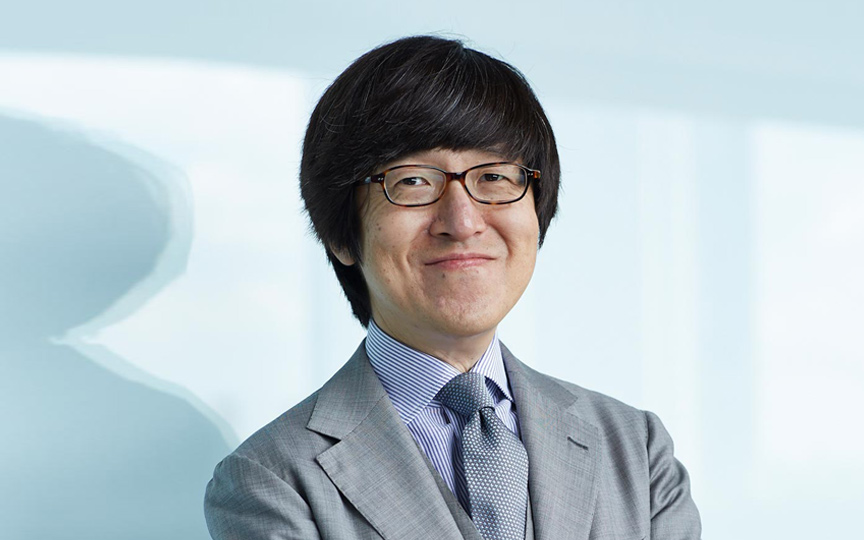Current State of Tourism and Hotel Industries Amid Changes Caused by COVID-19
Scroll Down
It has been some time since restrictions were placed on the movement of people due to COVID-19, and the travel and hotel industries seem to be at a crossroads. What can hotels do to enrich people’s lives and to present the distinct features of Japan’s various regions to fascinate people?
Hiroaki Otani (Photo: right), Chief Design Officer of Nikken Sekkei spoke with Tomohiko Sawayanagi (Photo: left), a long-time real estate investment advisor in the hotel industry and currently professor at Rikkyo University’s Graduate School of Business.
Current State of Tourism and Hotel Industries Amid Changes Caused by COVID-19
Sawayanagi: Hotels may contribute to society by paying taxes, such as property tax and corporation tax, but the spread of COVID-19 has highlighted the problems that the hotel industry has faced. Before the pandemic, overnight-stay-based hotels were built in order to attract more inbound guests with smaller budgets. And these so-called limited service hotels offering relatively large rooms with breakfast were not places the nearby residents would ever visit. That led to a large number of hotels that do nothing to contribute to and had no interaction with the functions of the communities where they stand.
Otani: Limited service hotels seem to function more or less like studio apartments.
Sawayanagi: Yes, they are similar. The pandemic suddenly forced hotels to find a different type of clientele. Before the pandemic, hotels had targeted visitors from as far away as possible, i.e., overseas and from large metropolitan areas, and had relied heavily on online marketing. Now they need to look for customers from within a radius of a few kilometers as well. The basic structure of a hotel—guestrooms, banquet halls, restaurants—could remain mostly the same, but the facility contents and marketing style have to change a great deal. In terms of the community’s resources, hotels should have had more functions that could serve for local people. What the hotel industry is experiencing, I would say, is a backlash from specialization in the “inbound leisure” market and concentrating on efficiency. Hotel chains are currently concentrating on providing contactless check in and check out, but procedures like that will soon become standard, so won’t be a feature that differentiates one hotel from another.
Otani: If we build an office building for a single function, with the enormous changes in the social environment that are expected it might not function at all in a few years. Flexibility and versatility will be required of buildings, programs, and the mindset of owners.
Sawayanagi: I agree with you. Hotels such as Ace Hotel Kyoto and Hotel the Knot are emerging to provide pleasant cafe spaces local residents can enjoy. I think the move becomes the first step in the right direction for the post COVID-19 era.
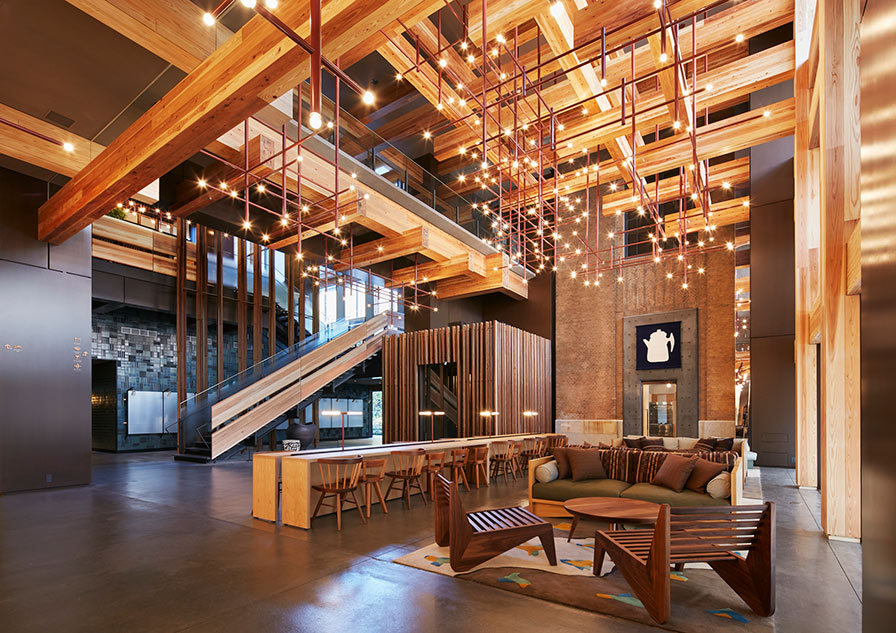 Ace Hotel Kyoto © Forward Stroke Inc.
Ace Hotel Kyoto © Forward Stroke Inc.
(Architectural design review: Kengo Kuma and Associates, Architectural design: NTT Facilities, Inc.,
Local interior design: Irie Miyake Architects & Engineers, Interior design: Commune Design, Project management: Nikken Sekkei)
Ace Hotel’s first hotel in Asia to launch a brand aiming for new expressions of culture and revitalization of the local community.
Sawayanagi: Starbucks is welcomed everywhere, and they have managed to fashion their facades to fit their locales. I think a hotel offering guestrooms in a similar mindset to Starbucks could become part of the community.
Otani: They would be welcoming, approachable, and comfortable. One could work there or have meetings. It would be interesting if we think of urban facilities (“third places”) which the locals can easily use on a daily basis also providing accommodation.
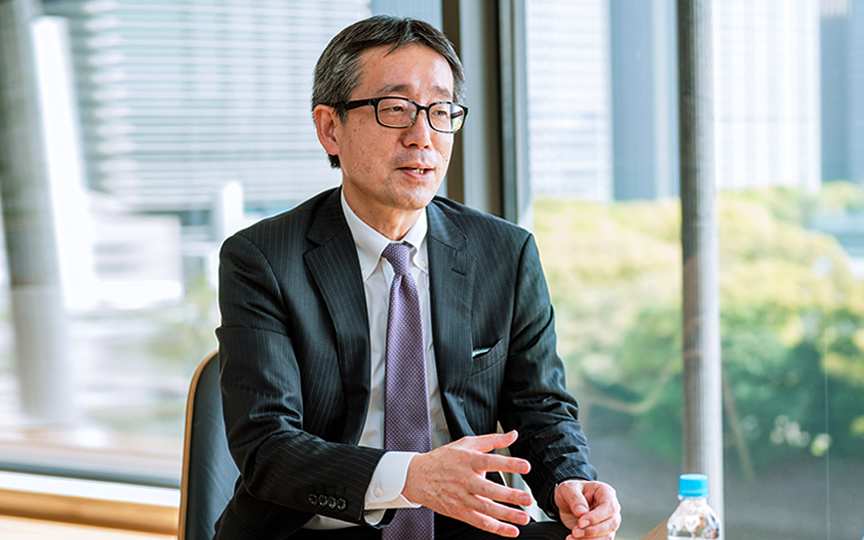
Back-of-House Is a Hotel’s Lifeline
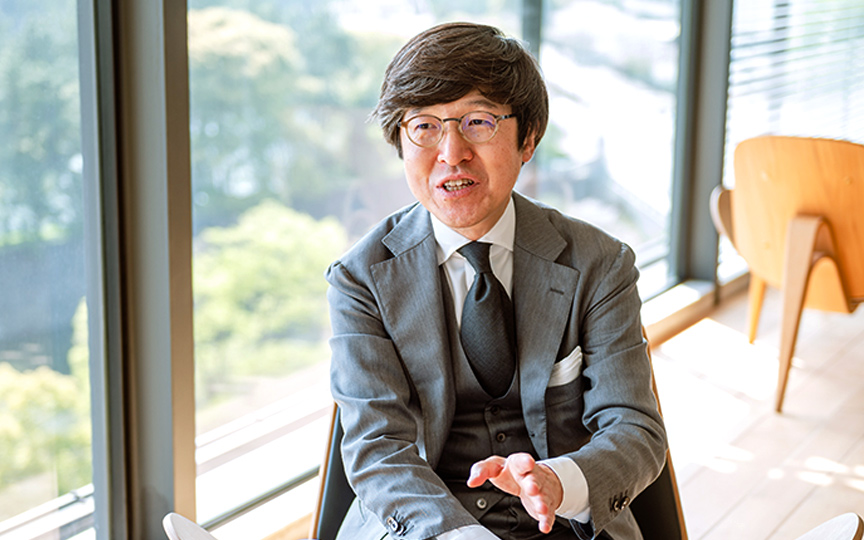
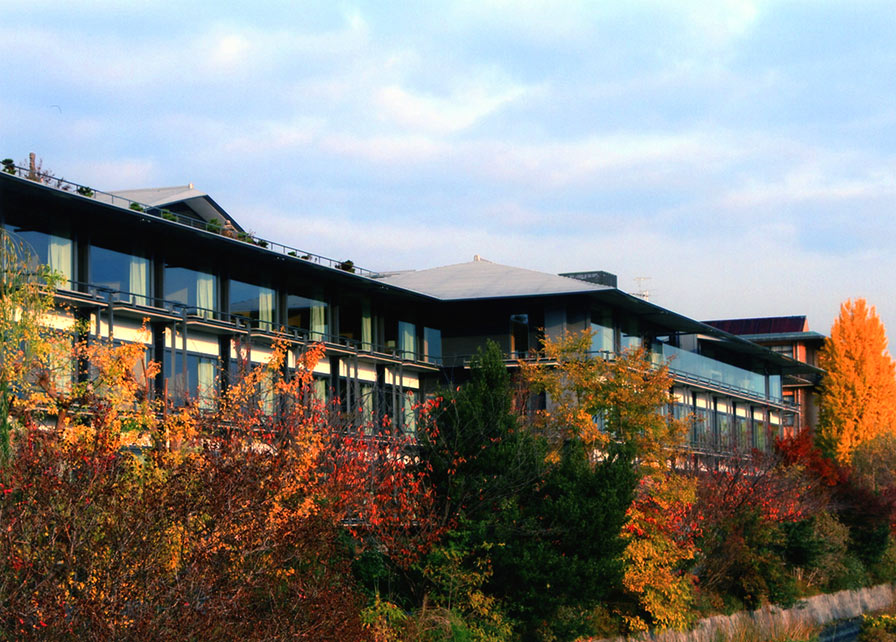 The Ritz-Carlton, Kyoto © Prise Koji Yamazaki
The Ritz-Carlton, Kyoto © Prise Koji Yamazaki
Luxury hotel on the banks of the Kamo river offers hospitality steeped in traditional Kyoto culture and panoramas of the Higashiyama mountains to the east.
Otani: In addition, it takes a few decades to be considered a great hotel. It’s quite difficult to design for a long span of time, isn’t it?
Sawayanagi: Quite right. Once a hotel is built, it is used for decades, but during that time, customers’ tastes change and the way hotels are operated may change as well. The difference between a hotel with ample back-of- house area and one without, becomes apparent. For example, it’s efficient to create a central kitchen and to deliver foodstuffs to restaurants on the first and the second floors, but when you decide to add a tenant restaurant later, backyard circulation can become an issue.
Otani: The back-of-house is to a hotel what the circulatory system or the digestive system is to the body. The building will not last if those functions are not robust. Few people outside the hotel business understand the importance of the back-of-house, because the services and people necessary for hotel operations all function behind the scenes.
Sawayanagi: That is true. For example, let’s say it was decided to cut back on the number of service elevators for employees by one, since customers would never see it. The service elevators could get overly busy during the peak times for in-room dining for breakfast, and suddenly that affects the efficiency of operations. Similar to the restaurant example mentioned earlier, the hotel might function well under one circumstance, but unless the behind-the-scenes circulation is well thought out, it won’t work under a different situation. This is not a problem that normally surfaces, and developers prioritize maximizing the area where money is made while minimizing investment in back-of-house design.
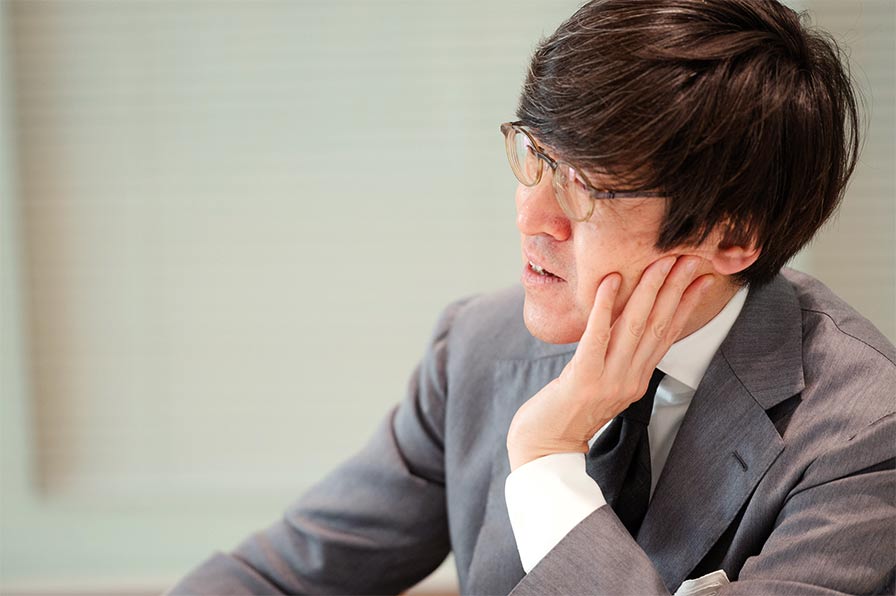
Behavioral Changes Bring Changes to Hotels
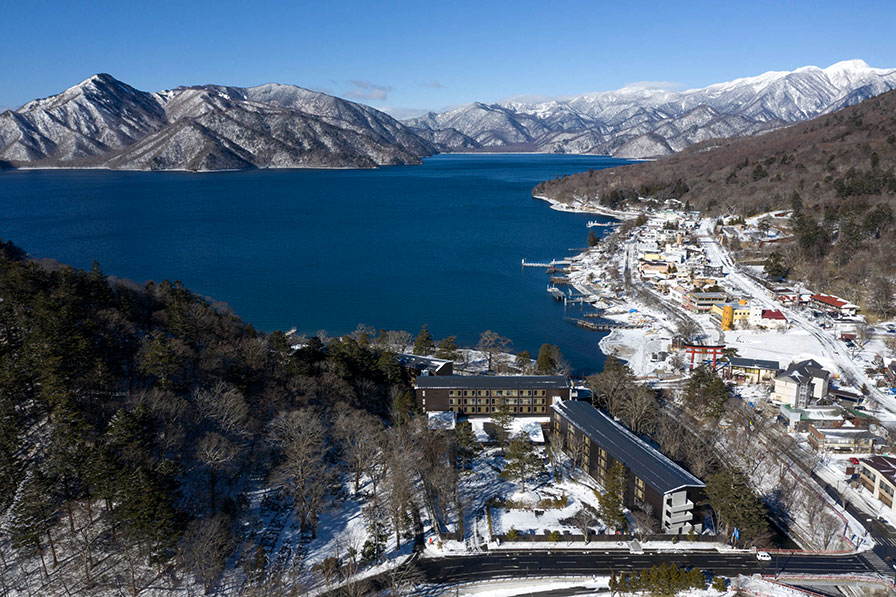 The Ritz-Carlton, Nikko © Ken’ichi Suzuki
The Ritz-Carlton, Nikko © Ken’ichi Suzuki
With sweeping views of the vast lake and mountain landscape, the villa resort at Nikko is one of Japan’s oldest vacation retreats.
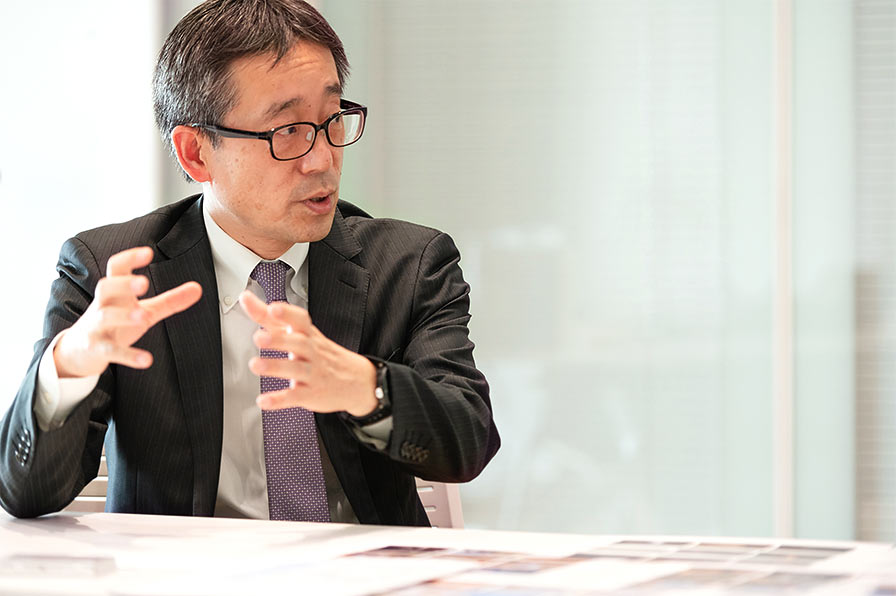
Sawayanagi: For example, because of the climate, hotels in Hawaii can market themselves as beach resorts throughout the year, but because you can’t swim in the winter in Okinawa, it is hard to sell your hotel as a beach resort in the winter. As yet, for example, no one has developed contents such as canoeing around the mangrove forest in the northern part of the island or exploring the Yambaru Forest during the winter season. Of course, such activities must not be destructive to nature, but if resorts in Okinawa could develop some winter contents, they could have year-round resorts with high unit prices and demand for accommodation in the peak season would be more evenly distributed. The timing of vacations is also important. Going to Okinawa in mid-August is expensive both in terms of airfare and accommodation. Many people don’t want to submit themselves to such tortures.
Otani: That’s the nightmare created by dynamic pricing.
Sawayanagi: When it’s the only time you can get vacation time you live with it. And this is why the CEO of Hoshino Resorts proposes changing the dates of the big holidays by prefecture. I believe it is important that companies have a program to encourage employees to take paid time off. Every year, the travel website Expedia publishes the results of a survey of 19 countries around the world comparing the number of paid days acquired and the rate of vacation time taken, and as far as I know, Japan has been dead last continuously for the last ten years. What further frustrates the hotel industry is that the Japanese tend to take short vacations. That is what has made building extended stay resorts pointless in Japan.
Otani: The generation has changed, but Japanese still don’t take vacations. It sounds like improvement of hotels might have to wait for diversification of vacation time.
Sawayanagi: We definitely need to change vacation behavior. That would increase the annual operation rate of resorts and improve profits, which would lead to the creation of more interesting resorts. We end up with uninteresting and tired resorts, because there is no money in it. Design may not be able to do anything to change that.
Otani: The inconvenient truth we uncovered in this conversation is that the issue is not with hotel facilities themselves! People will need to be persuaded to start this new behavior. I think we can change if we want, especially the younger generation.
Sawayanagi: Indeed. The “workation” is becoming popular, though it hasn’t really yet taken hold. People who wouldn’t take a vacation because of a single weekly meeting on Monday afternoons can now join meetings from a resort for one hour.
Otani: Yes, you may see ocean in the background. It’s very nice.
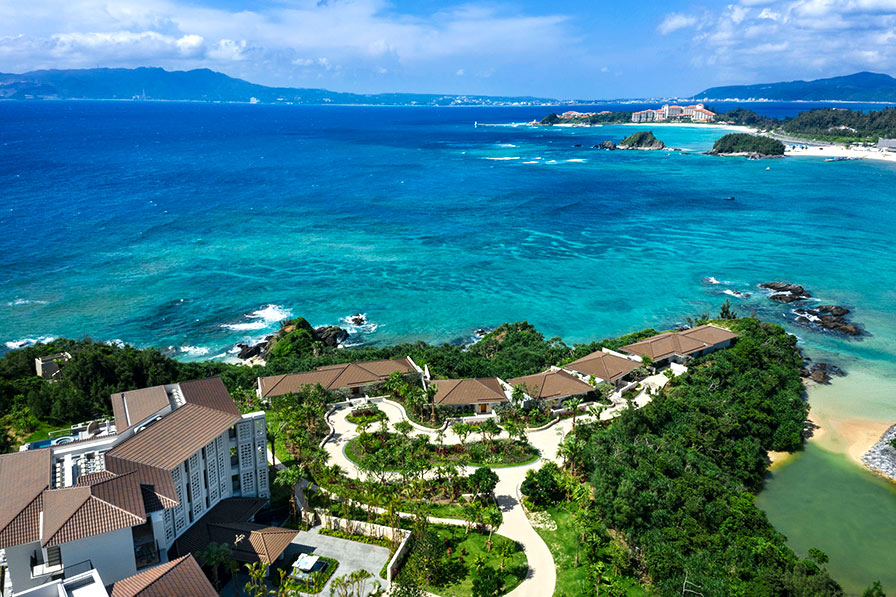 Halekulani Okinawa © Nacasa & Partners
Halekulani Okinawa © Nacasa & Partners
Diverse scenes of lush greenery and azure seas come together for once-in-a-lifetime experiences only to be found in Okinawa.
Presenting Japan to the World
Sawayanagi: I’m sorry not to mention one in Japan, but I like the Four Seasons Resort Bali at Sayan, located in the mountains near Ubud, which is known as Bali’s center of culture and the arts. When you arrive at the porte-cochere, you have no idea that there are buildings. But as you cross the suspension bridge over a cliff, the gorge opens up in front of you. You go down and reach the lobby floor, and then you see the villas that look like gazebos on the flats at the bottom of the gorge. Guestrooms and restaurants are tucked into the cliff by the side of the river. There are rice paddies, too, although they are not very large, and the whole thing is like a completely separate, independent world. I was really impressed. It leverages the elevation changes created by nature in a really clever way. That’s a design you can’t copy and paste.
Otani: I guess it’s important that the owner has the ability to secure a large piece of land for such a hotel development.
Sawayanagi: True. Another resort hotel I like, Gili Lankanfushi Maldives, has a spa where part of the floor is done in glass so you can get your treatment while watching coral and fish in the ocean. In addition to the water villas connected to land by piers, there are seven freestanding water villas that can only be reached by a boat. One might argue that building water villas threatens the ecosystem and should be avoided, but the environment is important for hotels, too, so they do pay attention to maintaining and conserving the environment. If a money cycle can be established where the hotel makes money by doing business, pays taxes, and that money is used to preserve the environment, I believe it would benefit the resort and the environment in the long run.
Otani: Hotels are coexisting with the environment while benefiting from it.
Sawayanagi: Of course there are great resorts in Japan, too, but when I look at examples like these overseas, I wish we could make resorts like them here in Japan.
Otani: I believe the time will come soon. However, the Japanese have a weak spot for foreign hotel brands. How can we change that?
Sawayanagi: First of all, the hotel owner needs to know what’s inside the hotel management contract. Up to now, when signing a contract with a foreign hotel operator (operating company), the only negotiation I notice is about fees and rates, and anything else is “okay, agreed.” There are many stipulations that can be placed, such as this or that needs to happen or the contract will be terminated, or, bad performance must be compensated for, etc., that the operator will not bring up. Japan is weak because we lack that kind of information. Most of the graduates of the hotel school at Cornell University where I studied became investors instead of operators, which contributes to quickly closing the information gap between owners and operators.
Otani: So the owner and operator can be on equal footing.
Sawayanagi: That’s right. The number of university faculties of tourism has increased in the last twenty years in Japan, too. However, while there are thousands of students, what they learn in most cases are “what is tourism” or that “hospitality and hospital share the same etymology” type of thing. That does nothing to bridge the gap, frankly. The real issue is that owners don’t prepare requests for proposals to invite a multiple number of operators for competitive bidding, which is normal practice overseas.
Otani: To do that, you need a powerful and well-informed ally, but there are only a handful of people in Japan with experience in implementing all aspects of a hotel agreement. If negotiations could be done properly, Japanese hotels would be on a stronger footing, and they would be able to get what they want. Also, it is evident and unavoidable that Japan’s GDP will decrease with the decrease in population. But we can’t let Japan become some kind of isolated Galápogos.
Sawayanagi: As a nation, Japan’s GDP ranks third in the world, but the per capita GDP is quite low at the 33rd. The decline is taking place quite rapidly.
Otani: Our challenge is how to stop the decline and how to tell the world about the rich and unique experiences Japan can offer, which I believe is intimately connected to the hotel and tourism industries.
Sawayanagi: The attractions that received attention from the world in the past were quite limited to things like Kyoto’s traditional townscape, temples and shrines, or skiing in Hokkaido’s Niseko, but things outside the old stereotype, such as cycling tours to Setouchi Shimanami Kaido across the Seto Inland Sea, are starting to sell. This creates diversity in destinations, which I believe is a great trend. I think the age of creating contents for the masses to attract group tours is over. Now the point is whether you can create something appealing and unique enough to attract people from far away, even if it means a smaller piece of the pie.
Dialogue Scene Photo: Masaki Komatsu
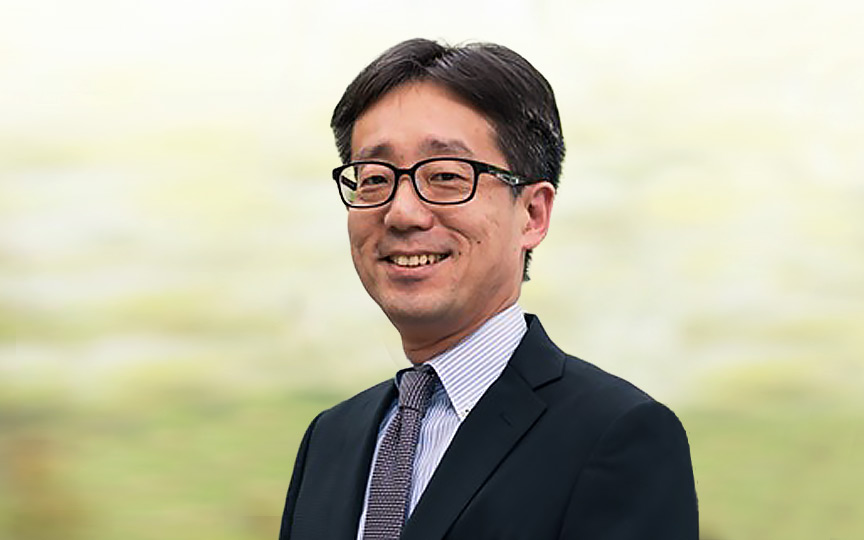
Tomohiko Sawayanagi
Specially Appointed Professor, Graduate School of Business, Rikkyo University
Representative Director, Brain Picks Incorporated (BPI)
